Chess advice from a grandmaster-physicist

Hello Everyone,
Grandmaster Vladimir Malakhov has a massive rating of 2725 Fide points. Add to that the tag of 'nuclear physicist' and you have one formidable chess player around.
Here is what he says about studying and training in chess.
His words on building an opening repertoire are great too.
"Selecting an appropriate opening repertoire is key when you’re playing with the black pieces. As a junior for many years I’d play 1…c5 in reply to 1. d4. Unfortunately it was only years later that I came to realize that it was a weak move, immediately giving up the centre and ensuring white an advantage. Meanwhile, after 1. e4 I’d play the Accelerated Dragon (1.e4 c5 2. Nf3 g6), but above a certain level, which was a real shock to me, it simply stopped guaranteeing equality. Therefore I concluded that when playing strong chess players I couldn’t immediately give them the initiative and… I decided on the Classical Dragon (2…Nc6) after 1. e4 and the Slav Defence with a6 after 1. d4."
"That was a proverbial bull’s eye! The Slav gives you equality very quickly, which improves my frame of mind at the very start of the game, while the Classical Dragon is much better than the Accelerated one, although there are, of course, lines in which white can pose black many problems."
"It’s a completely different matter to build an opening repertoire for white. I’ve already tried everything and, to tell the truth, I don’t know how you can obtain an advantage playing with that colour against a top-class opponent. In order to get a better position in any line you need to devote a lot of work to studying games and analysing key positions. Often it turns out that in order to obtain an advantage around the 27th move you have to work intensively for a whole month! And I don’t like to do that, as no-one can guarantee me that the work I put in will be converted into tangible results. So I rely on versatility, by which I mean an advanced, but perhaps not especially deep, understanding of the most varied range of possible opening lines."
The grandmaster says this for the following game: "Then, for a particular opponent, you can simply choose the one which will be most unpleasant for him. And it works. In one of the games from this year’s World Cup, against Mamedov of Azerbaijan, I chose an apparently unpromising opening line, but one which really didn’t suit my opponent, and the result of the game was already determined after 10 moves!"
PGN: . e4 c5 2. Nf3 d6 3. c3 Nf6 4. Be2 g6 5. O-O Bg7 6. Bb5+ Nc6 7. d4 cxd4 8. cxd4 O-O 9. Nc3 Bg4 10. Be3 d5 11. e5 Ne4 12. Rc1 Nxc3 13. Rxc3 Qb6 14. Bxc6 bxc6 15. Qc2 Rab8 16. b3 Rbc8 17. Rc1 Bf5 18. Qd2 f6 19. Rc5 Bg4 20. Ne1 Bf5 21. Nd3 Bxd3 22. Qxd3 Qb7 23. exf6 exf6 24. Qc3 f5 25. g3 Qe7 26. Rxc6 Rxc6 27. Qxc6 Qe4 28. Qd7 Rf7 29. Rc8+ Bf8 30. Rxf8+ Rxf8 31. Bh6 Qe1+ 32. Kg2 Qe4+ 1-0
From Alexandra Kosteniuk's
Also see her personal blog at
Labels: chess advice, grandmaster




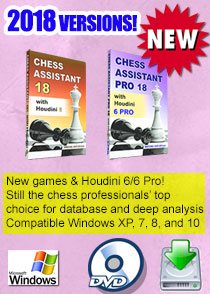












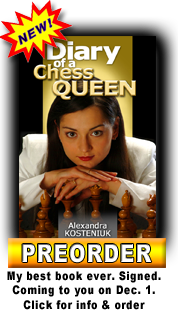










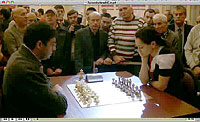
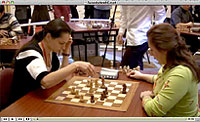
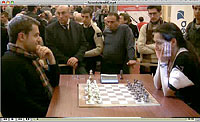

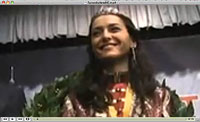

0 Comments:
Post a Comment
Note: Only a member of this blog may post a comment.
Subscribe to Post Comments [Atom]
<< Home